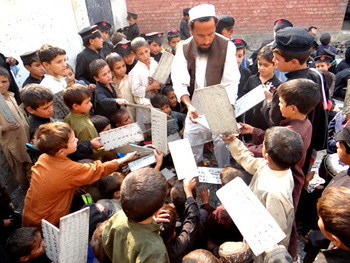Promoting basic education
Project description
Title: FATA Development Programme – result area: promoting basic education
Commissioned by: German Federal Ministry for Economic Cooperation and Development (BMZ)
Country: Pakistan
Lead executing agency: FATA Secretariat
Overall term: 2009 to 2015

Context
Pakistan's Federally Administered Tribal Areas (FATA) lie on the country's border with Afghanistan. This region is characterised by great need and a whole host of overlapping and often violent conflicts. In the FATA, there are no state structures at municipal level. The population is only involved in decision-making through their traditional tribal representatives. However, the last few years have seen these representatives lose much of their backing from the population or fall victim to targeted attacks by militants. The state is very limited in its ability to provide basic social services. The marginalisation of large swathes of the population, a dearth of opportunities for participation in decision-making processes, and a lack of access to basic services and income-generating activities have all engendered a deep sense of government distrust among the population. The associated sense of powerlessness and deep frustration serves as a breeding ground for extremism. The FATA region is very difficult for outsiders to access, with most of the population cut off from the progress being made within Pakistan generally.
Objective
The quality of school teaching in the FATA region has improved. Necessary conditions, such as a better institutional framework, have been created.
Approach
Reforming the education sector is essential if sustainable improvements are to be made to school teaching. Conducting an accurate analysis of the sector and existing deficits in the relevant institutions ensures that the reform plan addresses the main weaknesses. At the same time, the Education Management Information System (EMIS) is being expanded to provide reliable long-term planning data. A school effectiveness model is being piloted at selected schools to demonstrate the benefits of improved school administration, systematic monitoring and a continuous support system. The reform plan is set to mainstream this approach within the education sector in the long term.
Results
With GIZ's assistance, the FATA Directorate of Education has conducted an analysis of the education sector in preparation for a comprehensive programme of reforms. The results have been fed into a strategic reform plan, which includes improvements to initial and in-service teacher training and the strategic use of EMIS. Civil-society representatives have been involved in the development of the reform plan through topic-based working groups and advisory meetings.
Staff from the Education Directorate have received training in gathering and processing reliable data for EMIS, a task which is essential in shaping policy and allocating resources according to need. Over 2,000 primary and middle schools in the FATA region depend on reliable information for professional and realistic planning.
Furthermore, the school effectiveness model has been introduced in 246 schools, 120 of them girls' institutions. As a result, 2,159 teachers have received in-service training in the delivery of maths, English and science lessons following the identification of major weaknesses in teaching methods and subject knowledge. Additionally, 1,173 teaching staff, school principals and education officers from the pilot schools have received instruction in general educational matters and topics such as self-reflection, teamwork and lesson planning. Parent-teacher committees have also been set up at 184 primary schools, helping to anchor educational investment by providing a platform for discussing ways to improve education provision at district and local level.
Evaluations have confirmed the positive impact that the approach has had on the learning achievements of almost 30,000 primary school students, with pupils from the pilot schools scoring 19 per cent higher on average in their tests than children from control schools. The measures are proving particularly beneficial to girls, who are even scoring 24 per cent higher on average than their counterparts in the control schools.